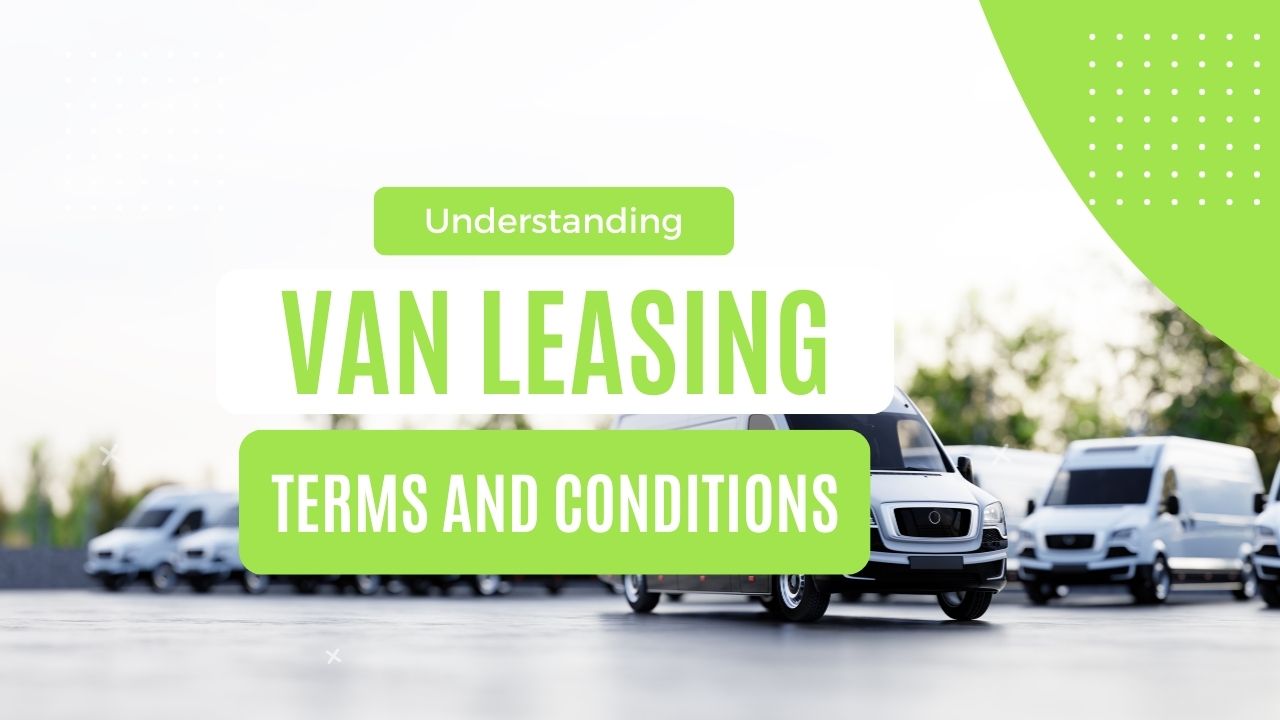Company Van Tax Explained
July 31, 2024

Leasing a van can be a smart and practical decision for many businesses and individuals. It allows you to have access to the vehicle you need without the upfront costs of purchasing it outright. However, before diving into a leasing agreement, it is crucial to fully understand the terms and conditions involved.
Understanding the lease terms and conditions is paramount in order to make informed decisions that align with your needs as well as protect yourself from any potential pitfalls or surprises down the road. Whether you are an entrepreneur looking for a reliable delivery van or an expanding business in need of additional vehicles, familiarizing yourself with these particulars will contribute to long-term success.
In this article, we will delve into various aspects of van leasing terms and conditions that deserve your attention. From mileage limitations to maintenance responsibilities, insurance requirements, and termination clauses - we will equip you with essential knowledge so that you can navigate through lease agreements confidently. So, let's explore these factors together so you can make sound decisions when considering van leasing options!
What is Van Leasing?
Van leasing is a cost-effective and flexible method of acquiring a van for commercial or personal use without the commitment of buying one outright. It involves entering into an agreement with a leasing company, where you can pay regular installments over an agreed period in exchange for the temporary use of a van.
There are two main types of lease agreements: financial lease and operational lease. A financial lease, also known as capital lease, is essentially a long-term rental agreement where the lessee has ownership-like rights and responsibilities throughout the contract duration. These leases typically last for several years and give you the option to buy the van at the end of term.
On the other hand, an operational lease, sometimes called a true or open-end lease, allows individuals or businesses to enjoy all the benefits of using a van without taking on any residual risk associated with its value when returning it at the end of term. This type of leasing arrangement provides more flexibility as there is no obligation to purchase at conclusion.
When choosing between these options, consider your business needs and financial goals. Financial leases may be advantageous if you intend to keep the vehicle long-term and want eventual ownership rights. In contrast, operational leases offer flexibility but do not grant ownership privileges.
Lease Duration
When it comes to van leasing, one of the most important decisions you'll need to make is the duration of your lease. The duration refers to the length of time that you will be leasing the van from the leasing company. Typically, there are a few options available when it comes to lease durations.
The most common choices for van leases are 24 months, 36 months, or 48 months. Each option has its own set of advantages and considerations that you should keep in mind before deciding. For example, if you have a stable business plan with long-term projections and anticipate needing a van for an extended period, opting for a longer lease term may result in lower monthly payments. On the other hand, if your business needs fluctuate or you prefer having flexibility and updating your fleet more frequently, choosing a shorter lease term may be more appropriate.
Factors such as budget constraints and anticipated mileage are also crucial in determining the ideal duration. Assessing how much wear and tear your vans typically endure over certain periods can help avoid unnecessary maintenance costs down the line. Furthermore, considering future industry developments or potential changes within your organization can guide whether committing to an extensive contract stint makes sense.
Ultimately, when choosing your lease duration for a van rental agreement — carefully weigh factors like stability versus adaptability alongside financial implications — ensuring that what you choose aligns with both immediate necessities as well as long-term goals
Mileage Allowance: Finding the Right Balance
One of the critical considerations when leasing a van is understanding the mileage allowance. A mileage allowance determines how many miles you are allowed to drive the leased vehicle during the contract's duration without incurring additional costs. This limit is set at the beginning of your lease agreement and directly impacts pricing.
The mileage allowance plays a pivotal role in determining monthly payments because it factors into calculating depreciation costs. Essentially, as you drive more miles on a leased van, its value decreases, which means higher risks for the finance company providing the lease. Therefore, exceeding your agreed-upon mileage can result in penalties or additional fees at an excess-per-mile rate.
Additional Costs Associated with Exceeding Mileage Limits
It’s essential to carefully consider your anticipated driving needs before agreeing to a particular mileage allowance. If you exceed your allotted miles, there will be extra costs involved at lease termination. These charges can vary depending on the leasing company but typically range from 10-30 cents per mile over your limit.
To put this into perspective, let's say you have leased a van for two years with a total allowable mileage of 24,000 miles (12k per year). However, due to increased business demands or personal circumstances beyond your control, you end up driving 28,000 miles by the end of year two – that is an excess of 4
Fair Wear & Tear Policy: Maintaining Your Leased Van
One important aspect to consider in van leasing is the Fair Wear & Tear policy. This policy outlines the acceptable condition your leased van should be returned in at the end of your lease term. Understanding this policy is crucial, as it helps prevent any unexpected charges for damage or excessive wear on the vehicle.
The Fair Wear & Tear policy sets guidelines for what constitutes acceptable wear and tear on a leased van. It is essential to know that reasonable wear and tear are expected during normal usage but not damage caused by accidents or neglect. Examples of acceptable wear and tear include minor scratches, scuffed bumpers, or slight upholstery stains resulting from everyday use. However, significant dents, missing parts, torn seats beyond normal deterioration, or modifications without prior consent would typically be considered excessive wear and tear.
By familiarizing yourself with the Fair Wear & Tear policy early on in the leasing process, you can better understand how to maintain your vehicle's condition throughout its lifespan. Regular cleaning and upkeep will help ensure you stay within accepted standards upon returning the van at lease-end. Additionally, documenting any existing damage before signing a lease agreement will protect you from potential disputes regarding pre-existing issues when it's time to return the vehicle.
Understanding what fair wear and tear entails allows you to plan ahead and take necessary precautions during your lease period so that you're well-prepared when it comes time to hand back your leased van. Keeping track of maintenance records and promptly addressing minor repairs can significantly minimize potential charges associated with excessive wear at lease-end
Insurance Coverage
One important aspect to consider when entering into a van leasing agreement is insurance coverage. It is crucial to understand whether insurance coverage is included in the leasing contract or if it needs to be obtained separately. In most cases, the lessee will be responsible for arranging and maintaining appropriate insurance for the leased van.
When it comes to types of insurance required, there are typically two main categories: comprehensive insurance and third-party liability insurance. Comprehensive insurance provides coverage for damage caused by accidents, theft, fire, vandalism, and other unforeseen events. It also covers personal injuries sustained in an accident. On the other hand, third-party liability insurance covers any damage or injuries caused by your vehicle to another person or their property.
It's essential to carefully read and understand the terms of the lease agreement regarding insurance requirements before signing on the dotted line. Some leasing companies may have specific minimum coverage amounts that must be met while others may require additional endorsements such as gap coverage (which covers any shortfall between what you owe on your lease and what your insurer pays out in case of total loss). By having adequate insurance coverage in place, you can protect yourself financially against potential risks associated with owning and operating a leased van.
Maintenance Responsibilities
During the term of a van lease, lessees are typically responsible for ensuring proper maintenance and care of the vehicle. This includes adhering to regular servicing requirements such as oil changes, tire rotations, and fluid checks. Failure to maintain the van in good working condition may result in additional charges or penalties imposed by the lessor at the end of the lease.
It is important for lessees to keep track of recommended service intervals and schedule appointments with authorized service centers accordingly. As part of their responsibility, lessees should also address any necessary repairs promptly to prevent further damage or safety issues. Neglecting essential maintenance can not only impact the performance and longevity of the van but may also risk violating terms outlined in the leasing agreement.
Additionally, van lessors often require that lessees provide documentation as proof of regular maintenance activities performed during the lease period. This can include invoices from authorized service providers or official records indicating date and mileage when specific services were conducted. By keeping thorough records, both parties have a clear understanding of how well-maintained the vehicle has been throughout its use.
Taking these steps demonstrates responsible stewardship while protecting against potential disputes regarding neglect or excessive wear-and-tear on returning leased vans at contract termination.
Comparing Offers from Different Providers:
i. Inclusion and Exclusion Points
When comparing van leasing offers from different providers, it's crucial to thoroughly review the terms and conditions to understand what is included and excluded in each lease agreement. While most agreements cover general maintenance and repairs, there may be variations between providers when it comes to specific services or additional costs.
For example, some leases might include road tax or breakdown cover as part of the package, while others may require you to arrange these separately. It's essential to consider your individual needs and preferences when evaluating these inclusion/exclusion points. Take note of any potential hidden costs that could affect your budget down the line.
ii. Fees, Costs, and Benefits Comparison
Another aspect that should not be overlooked when assessing different van leasing options is a thorough comparison of fees, costs, and benefits associated with each provider. Start by examining the monthly rental fee – does it align with your budget? Additionally, delve into any upfront payments required at the start of the lease term.
Consider unforeseen circumstances as well – are there penalties for early termination if business priorities change unexpectedly? Compare administration fees among providers as they can vary significantly. Moreover, don't forget about mileage restrictions: some contracts might allow more flexibility while others have stricter limits which could incur excess mileage charges.
Ultimately compile all this information so that you can make an informed decision based on what best matches your requirements from both a financial standpoint but also taking into account other conveniences such as service benefits- say pick-up/drop-off services being offered by certain companies - that one might value more than others during their usage tenure
Penalties for Early Termination - Consequences of terminating the lease early - Explain whether there are alternative solutions if necessary
Terminating a van lease early can come with significant financial consequences. When you sign a lease agreement, you commit to a specific term during which you will make monthly payments. However, unforeseen circumstances may arise that require you to terminate the lease before its agreed-upon end date.
In such cases, most leasing companies impose penalties and fees for early termination. These penalties can vary depending on several factors such as the remaining time on the lease, the value of the vehicle at termination, and any mileage restrictions specified in your agreement. Some leasing companies may charge all outstanding payments plus an additional penalty fee when terminating early. It is crucial to carefully review your contract and understand what these penalties entail before signing up for a van lease.
If circumstances necessitate ending your van lease prematurely, it's worth exploring alternative solutions with your leasing company or lender. One option might be finding someone willing to assume or take over your lease payments through a process known as transferring or swapping leases. This allows another individual to take responsibility for making regular monthly payments until the original end date of the lease agreement is reached. Alternatively, some leasing companies may offer buyout options that allow lessees to purchase their leased vans outright before completion of the original term, though this may have added costs associated with it.
Understanding both the potential penalties and possible alternatives will help ensure that you make informed decisions when considering ending a van lease earlier than expected
Once the lease term is nearing its end, lessees are presented with a few options regarding what to do next. The most straightforward option is returning the van to the lessor. This involves arranging an inspection of the vehicle to ensure it meets acceptable wear and tear standards as defined in the lease agreement. If any excessive damage or mileage overages are identified, additional fees may be incurred.
Another option available at the end of a lease is opting to renew or extend the lease for a certain period of time. This can be beneficial if you still have a need for regular access to a van but do not want to commit to purchasing one outright. Renewing or extending your lease gives you continued usage without having to worry about any immediate obligation towards ownership.
Lastly, some leasing agreements offer lessees the opportunity to purchase their leased vehicle at fair market value once the lease term concludes. This can be advantageous if you have grown fond of using that particular van and wish to retain it permanently. However, before pursuing this route, it's important to consider whether buying out the remaining balance would make financial sense when compared with purchasing a different new or used vehicle on similar terms.
When considering which end-of-lease option is best suited for your circumstances, it's crucially important read through your specific leasing contract thoroughly and familiarize yourself with any related costs such as excess mileage fees or termination charges should you choose not to go through with purchasing or renewing/extending your current agreement.
Overall flexibility will vary depending on different leasing providers and their policies - so reviewing these options well in advance will ensure smoother decision-making while also potentially avoiding last-minute surprises that lead

